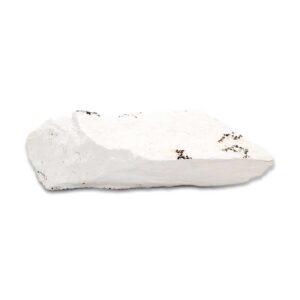
Pottery stone has long been important as a raw material for porcelain in Japan, and is still a major raw material today. It is also indispensable as a raw material for sanitary ware, tiles, and hard ceramics. The quartzite is a volcanic rock called quartz coarse-grained rock that undergoes hydrothermal action, and the feldspar and other elements within it are converted into clay, while sulfurous acid gas washes away iron compounds, making it a convenient raw material for porcelain. However, if the stone is simply pulverized, the amount of quartz is too large to be molded, so the stone is pulverized to remove as much clay as possible from between the quartz grains. In the industrial process, all of the quartz grains are pulverized and plastic clay is added to make clay. The most widely used raw material for porcelain in Japan today is Amakusa pottery stone. This pottery stone is composed of quartz, silica mica, and a small amount of kaolinite, and is sometimes tan in color with a thin film of iron hydroxide, and in other places, the iron hydroxide is soaked into the interior of the pottery stone. The composition of amakusa pottery stone is itself the composition of porcelain base, and since the amount of silica mica and kaolin is around 30%, it is understood that molding is relatively easy. The representative pottery stone used as a raw material for sanitary ware is Hattori pottery stone from Ishikawa Prefecture, which is made of green tuff that has been altered by hydrothermal action. Since this pottery stone contains a large amount of titanium dioxide and iron oxide, it turns rat gray after reduction firing and is used as a raw material for semi-polished porcelain and hard pottery base materials that undergo oxidizing firing. Arita porcelain and Kutani porcelain are the two most famous porcelains in Japan, both of which are made from quartz coarse-grained rocks produced in the region that have been altered by hydrothermal action. Senzanite, the raw material for Arita-yaki, is composed of quartz, feldspar, and silica mica, and is broadly classified into magnetite, celadonite, and glaze stone. Magnets are used for the base material, and celadonite, with its dense, iron-rust surface, turns blue when fired and is used for the celadon glaze material.
Glaze stones are used as glaze material because they are white in color and rich in hard alkali components. Pottery stone, the raw material of Kutani ware, is called Hanasaka-ishi, Shorenji-ishi, Tsuru-no-Yama-ishi, Gokokuji-ishi, and other names depending on its place of origin. In recent years, large quantities of pottery stones have been produced in the Kamioka and Kiyomi areas of Gifu Prefecture, and are used as raw materials for tiles, semi-porcelain, and white hard porcelain according to their respective properties, helping to improve the quality of conventional Mino ware. (“Ceramics for Crafts,” “Glazes and Their Pigments,” “Gito Trial Report”)



